PCIe SSD Faceoff: Samsung XP941 (128GB & 256GB) and OCZ RevoDrive 350 (480GB) Tested
by Kristian Vättö on September 5, 2014 3:00 PM EST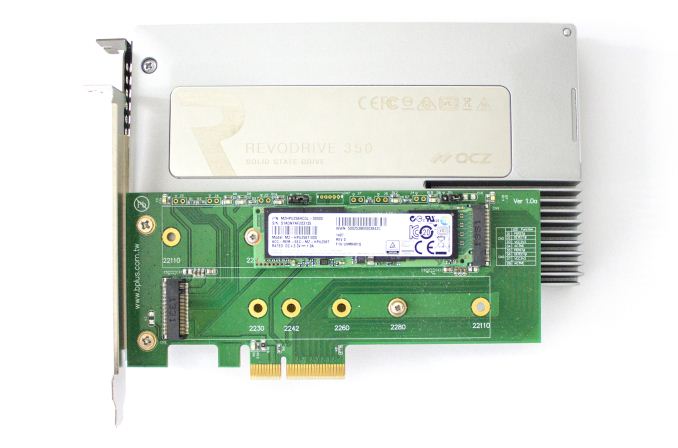
We are currently on the verge of PCIe transition. Nearly every SSD controller vendor has shown or at least talked about their upcoming PCIe designs, and the first ones should enter the market in early 2015. In the meantime, there are a couple of existing PCIe drives for the early adopters, namely Samsung XP941 and Plextor M6e, and a variety of RAID-based PCIe SSDs like the OCZ RevoDrive 350.
We already reviewed the 512GB Samsung XP941 in May and found it to be the fastest client SSD on the market, but today we are back with the 128GB and 256GB models. Since the XP941 is not limited by SATA 6Gbps interface, the capacity of the drive can have a substantial impact on performance, even between 256GB and 512GB models, because PCIe moves the bottleneck from the host interface to the actual NAND.
In addition to the smaller capacity XP941s, we are taking a look at OCZ's RevoDrive 350. Unlike the XP941, the RevoDrive 350 is not a native PCIe drive as it has several SATA 6Gbps SSD controllers in a RAID configuration to increase the performance over a standard SATA drive. The RevoDrive 350 is not a new drive since it was released back in April, but due to my finals I did not have the time to review it for the launch, but it makes sense to put it against the XP941 now.
Samsung XP941
The 128GB and 256GB XP941 both come in M.2 2280 form factor like the 512GB model. However, the 128GB and 256GB models are single-sided whereas the 512GB model has NAND packages on both sides of the PCB. As a result the 512GB is slightly thicker, but by eye I would say we are dealing with something in the order of 0.1mm (the 128GB and 256GB models do have some circuitry on the back side too, just not NAND packages). Some M.2 implementations (though mostly mobile) can have strict height restrictions, but the difference between the 128GB/256GB and 512GB XP941s is so tiny that it should not be a limitation, although you might want to check that your M.2 slot is suitable for the XP941 in the first place (the XP941 has max height of 3.73mm).
| Samsung SSD XP941 Specifications | |||
| Capacity | 128GB | 256GB | 512GB |
| Interface | PCIe 2.0 x4 (AHCI) | ||
| Controller | Samsung S4LNO53X01 | ||
| NAND | Samsung 64Gbit 19nm MLC | ||
| Sequential Read | 1000MB/s | 1080MB/s | 1170MB/s |
| Sequential Write | 450MB/s | 800MB/s | 950MB/s |
| 4KB Random Read | 110K IOPS | 120K IOPS | 122K IOPS |
| 4KB Random Write | 40K IOPS | 60K IOPS | 72K IOPS |
| Power (idle / active) | 0.08W / 5.8W | ||
| Warranty | Three years (from RamCity) | ||
| Online Pricing | $130 | $250 | $750 |
Thanks to RamCity for providing us with the 128GB, 256GB and 512GB Samsung XP941 samples!
Performance wise there are fairly large differences between capacities. The 128GB model provides less than half the sequential write performance of the 512GB model and 450MB/s is within the SATA performance envelope. Random write speed also experiences a substantial decrease, but read performance stays mostly the same. That is because of the way NAND works: reading is fast because the controller is just checking the charge in the cell, but writing is slow because you need to tunnel electrons through an insulator to create the actual charge in the cell.
As I mentioned in the original XP941 review, the SSD is not bootable on most motherboards. The drive does not have legacy BIOS drivers that load before the BIOS (like the RevoDrive 350 has), so it requires specific BIOS/UEFI code to be bootable. Fortunately the situation has improved since May and in addition to the ASRock Z97 Extreme6, most of ASUS' Z97 motherboards support booting from the XP941. RamCity has a good blog post about the supported motherboards and laptops, including some links to instructions in case the XP941 is not bootable by default. Furthermore, the XP941 is still bootable on a Mac Pro (except for the 2013 model) as we discovered in our original review.
All XP941s use Samsung's 64Gbit 19nm MLC NAND. The 128GB and 256GB models both have two NAND packages, so these are octal-die packages for the 128GB and 16-die packages for the 256GB.
Unfortunately, my 128GB sample died during the testing, so I do not have all benchmark scores for it. I am not 100% sure what killed the drive (it would not show up when I returned from Flash Memory Summit) but I am pretty sure it was secure erase. I am not the first one to experience this as RamCity was telling me that other reviewers have had the same problem and RamCity actually has a warning about using Parted Magic to secure erase the drive. I did not use Parted Magic but it looks like secure erase in general can break the XP941. I do not think this is a big issue for users because most will not be secure erasing the drive, but I still wanted to give a heads up and advise against secure erasing the XP941.
OCZ RevoDrive 350
The RevoDrive 350 is OCZ's first client PCIe SSD since the RevoDrive 3 (X2) back in 2011, but fundamentally the two are still very similar. Like the RevoDrive 3, the RevoDrive 350 is also based on two or four SandForce SF-2200 series controllers in a RAID array, but with the difference that the 350 uses SF-2282 controllers while the RevoDrive 3 used SF-2281. The two controllers are the same except for the channel width, which is 8 bytes in the SF-2281 and 16 bytes in the SF-2282. The 16-byte wide channel can talk to twice as many NAND die, which allows for larger capacities and can also provide some minor performance increases in scenarios where performance is limited by NAND channel bandwidth.
The RevoDrive 350 comes in three capacities with the capacity dictating the controller configuration. The 240GB model only has two SF-2282 controllers, although that makes sense because more controllers would not really improve performance at such a small capacity. With four controllers the 240GB model would only have 64GiB of NAND per controller, which would severely limit the potential performance of the controllers. The 480GB and 960GB models, on the other hand, feature a total of four SF-2282 controllers with 128GiB and 256GiB of NAND per controller respectively. Despite the different number of controllers, all capacities utilize the same PCIe 2.0 x8 interface.
| OCZ RevoDrive 350 Specifications | |||
| Capacity | 240GB | 480GB | 960GB |
| Interface | PCIe 2.0 x8 | ||
| Controller | 2x SF-2282 | 4x SF-2282 | |
| NAND | Toshiba 64Gbit 19nm MLC | ||
| Sequential Read | 1000MB/s | 1800MB/s | 1800MB/s |
| Sequential Write | 950MB/s | 1700MB/s | 1700MB/s |
| 4KB Random Read | 45K IOPS | 90K IOPS | 135K IOPS |
| 4KB Random Write | 80K IOPS | 140K IOPS | 140K IOPS |
| Power (Idle / Active) | 8.0W / 10.5W | 9.5W / 14.0W | 10.0W / 14.5W |
| Encryption | AES-128 | ||
| Endurance | 50GB per day for 3 years (54.75TB total) | ||
| Warranty | Three years | ||
| Online Pricing | $517 | $810 | $1260 |
The main reason OCZ updated its RevoDrive is to transition to Toshiba NAND. The RevoDrive 3 used NAND from Micron, but thanks to Toshiba's acquisition, OCZ now has direct NAND access and it no longer needs to seek for third party NAND. I think part of the deal was that OCZ transitions all of its products to Toshiba NAND because it would not make sense for Toshiba to support its competitors' NAND business.
The front side of the PCB is covered by a hefty metal heat sink. Removing the heat sink does not reveal the actual SF-2282 controllers but a series of NAND, power circuitry and the RAID controller. OCZ has labeled the RAID controller with its own logo but I was told the actual silicon comes from Marvell. A quick look at Marvell's lineup reveals that the controller is most likely 88SE9548, which is a 4-port SAS/SATA 6Gbps RAID controller with PCIe 2.0 x8 interface, and would thus fit the description. The firmware is still à la OCZ, though.
Officially OCZ calls the controller Virtualized Controller Architecture (VCA) 2.0. With its own driver and firmware, OCZ treats data differently from a regular RAID-0 controller by not having a striping nature. Instead of having a set stripe size and distributing data evenly across the controllers, the VCA incorporates internal IO queues to distribute the IOs between the controllers. The benefit is that this way OCZ can have better control over every controller and can also ensure that one member in the array is not writing more data than the others.
The unique driver and firmware also allow the RevoDrive 350 to support TRIM, SMART, and secure erase while typical RAID controllers do not allow those features. The RevoDrive is also bootable because the legacy drivers are loaded before the motherboard BIOS, so it can be selected as a boot device like any other drive.
On the back side we find the SF-2282 controllers along with more NAND packages. I counted 32 NAND packages in total (i.e. 512GiB of NAND), which means that each package must be 16GiB with two 8GiB dies inside.
Test Setup
| CPU | Intel Core i5-2500K running at 3.3GHz (Turbo & EIST enabled) |
| Motherboard | AsRock Z68 Pro3 |
| Chipset | Intel Z68 |
| Chipset Drivers | Intel 9.1.1.1015 + Intel RST 10.2 |
| Memory | G.Skill RipjawsX DDR3-1600 4 x 8GB (9-9-9-24) |
| Video Card | Palit GeForce GTX 770 JetStream 2GB GDDR5 (1150MHz core clock; 3505MHz GDDR5 effective) |
| Video Drivers | NVIDIA GeForce 332.21 WHQL |
| Desktop Resolution | 1920 x 1080 |
| OS | Windows 7 x64 |
Thanks to G.Skill for the RipjawsX 32GB DDR3 DRAM kit


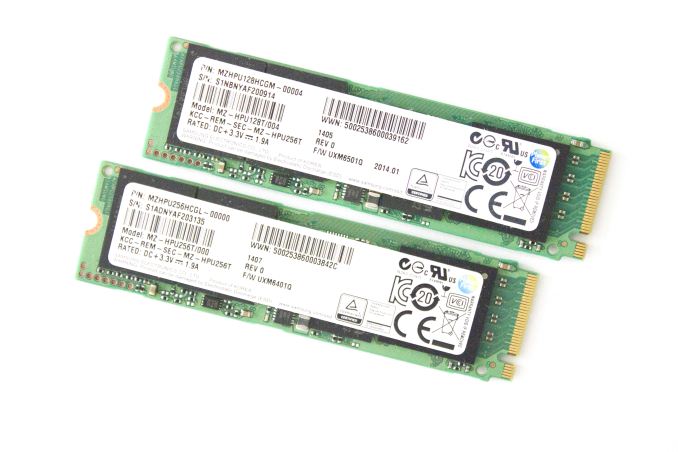
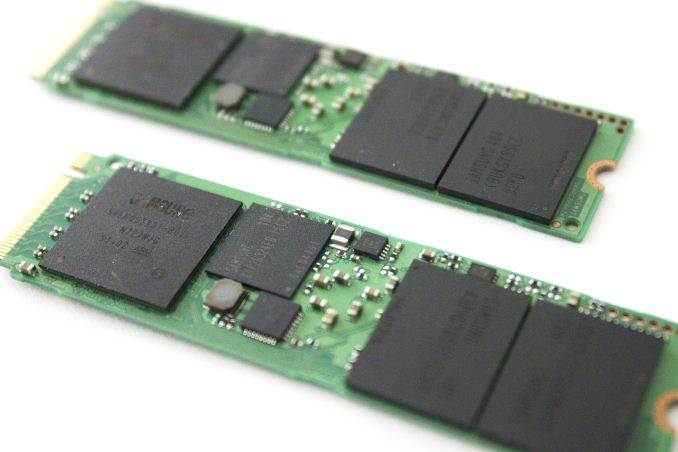
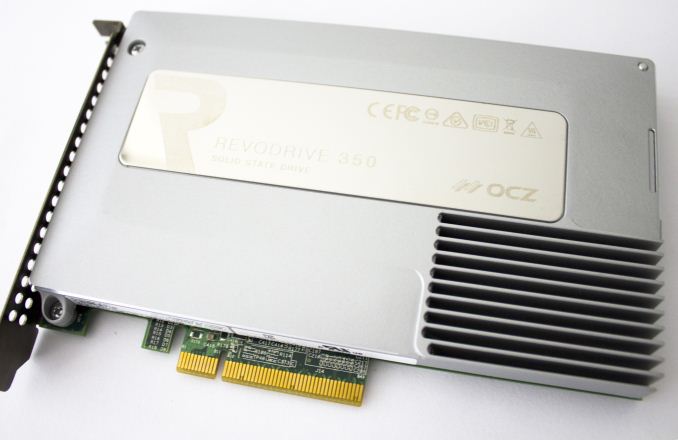
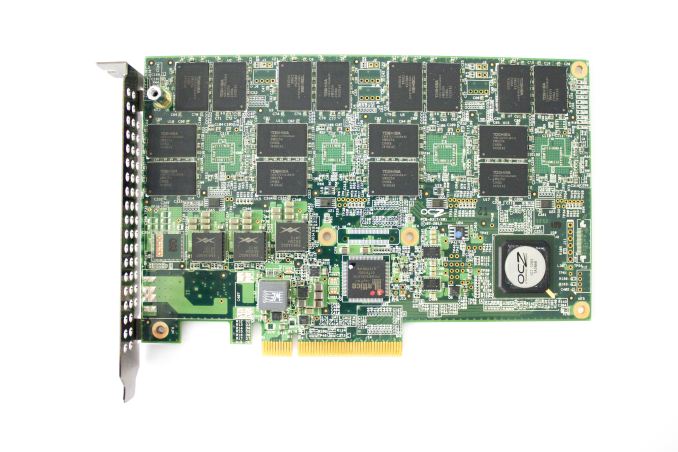
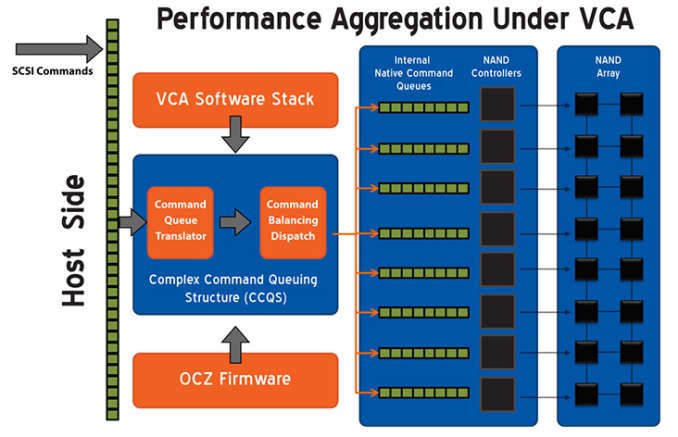
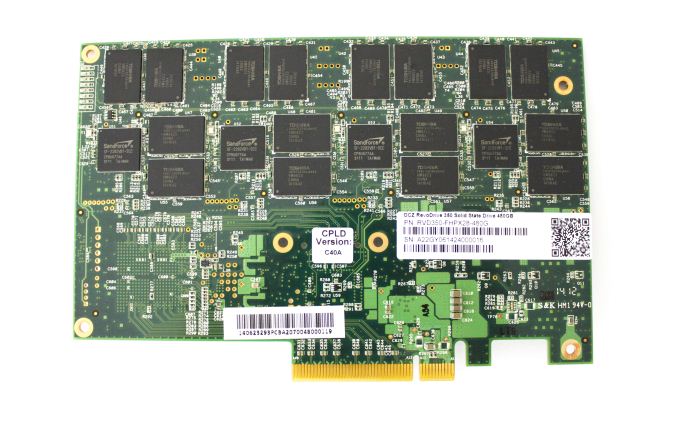








47 Comments
View All Comments
Intervenator - Friday, September 5, 2014 - link
Need MOAR insight into the PCIe SSD market! Wheres it going? Any noticeable performance increased to the end user? Who are the players in the market? Non performance advantages?If AnandTech has already written an article regarding any of this, could someone please point me towards it?
Intervenator - Friday, September 5, 2014 - link
Oh, and great review.Kristian Vättö - Friday, September 5, 2014 - link
We haven't done an article that collects all bits of info into one, but you may find the following articles interesting:http://www.anandtech.com/show/8006/samsung-ssd-xp9...
http://www.anandtech.com/show/7843/testing-sata-ex...
http://www.anandtech.com/show/7520/lsi-announces-s...
http://www.anandtech.com/show/8147/the-intel-ssd-d...
http://www.anandtech.com/show/8104/intel-ssd-dc-p3...
frenchy_2001 - Friday, September 5, 2014 - link
>Where is it going?M.2 form factor using PCIe gen3 x4 for portable and consumer, PCIe cards, up to Gen3 x8 for Datacenter/server. Both running NVMe protocol.
I don't see much future for SATAexpress, as the 2 other competing standards cover all the use cases already (and better too).
> Any noticeable performance increased to the end user?
Not unless you do a LOT of parallel IOs. For consumer, there is a diminutive return past the original boost from switching to SSD (mostly from lower latencies). HDD to SATA SSD gave orders of magnitude improvements. SATA3 -> PCIe is only incremental compared to that. Unless you need this for a server, video processing or other big IO limited task, there will be little difference.
>Who are the players in the market?
Still the same: Intel/Micron/Samsung/Sandisk for professionals/servers using mostly in-house designs (intel P3700 for example).
Marvel and Sandforce have announced PCIe NVMe controllers. No products for those yet.
>Non performance advantages?
M.2 will be more compact. Power draw should be more optimized. NVMe should have lower processor overhead.
Impulses - Friday, September 5, 2014 - link
Thx for that.iwod - Saturday, September 6, 2014 - link
Since speed is a relative thing. The HDD to SSD leap were amazing. But that doesn't mean you cant feel the different between SSD @ SATA 3GBps and SSD@ 6Gbps. And with the recent controller improvement on Random / Seq RW, I can also feel the difference between SATA and NVMe PCIe SSD.But with the increase memory capacity, the time to fetch things SSD will also be lower since they are likely cached. So throughput may become less of a concern after PCIe SSD, and average response time will play a role. Luckily this is already being worked on for server SSD usage. So they will likly filter down once PCIe SSD becomes mainstream.
For the future I would like to see even lower active power consumption. I wonder if they could get it under 2W.
Friendly0Fire - Friday, September 5, 2014 - link
This makes me think that the SM951 with X99 will be one hell of a beast... I want one. Heck, the XP941 would already be amazing.GrigioR - Friday, September 5, 2014 - link
Is it possible to boot from those PCIe drives using a 775 motherboard (p35chipset)? Getting rid of Satall bottleneck would be awesome on my modded Xeon system.Kristian Vättö - Friday, September 5, 2014 - link
The SM951 likely won't be bootable since it is an OEM drive, but there will be retail PCIe SSDs that are bootable even in older systems (the Plextor M6e should be, for instance).GrigioR - Sunday, September 7, 2014 - link
Nice. Too pricey 1$/GB on the 256GB model... Since my motherboard is PCIe 1.0/1.1 it would run at 500MB/s max... That should not be that noticieable. My Samsung 840 120/128GB runs at +- 250-260MB/s (read)... At least if it were a PCIe x4 it would do 1000MB (bus speed). I`ll leave this the way it is for now. Thank you very much for your input. Now i know it is possible.